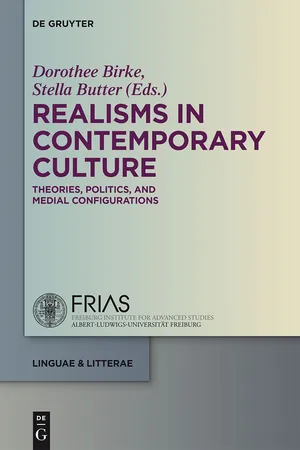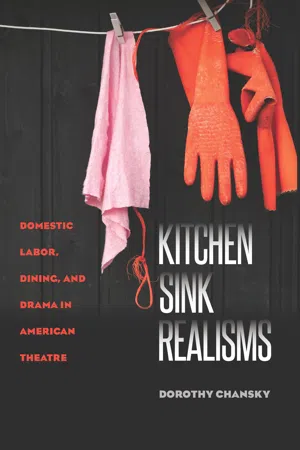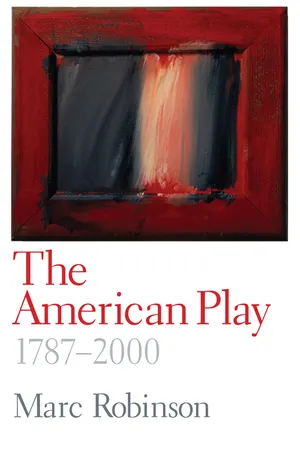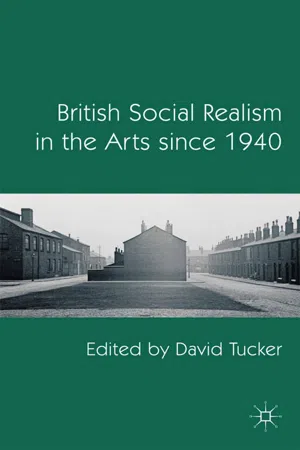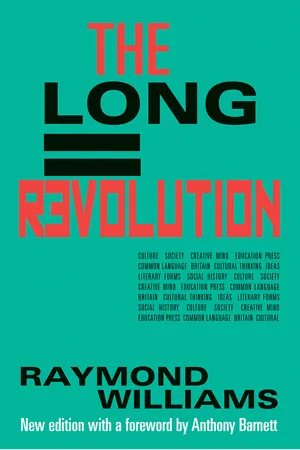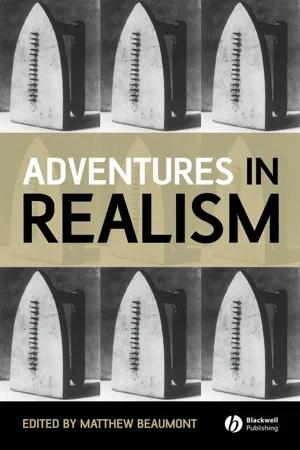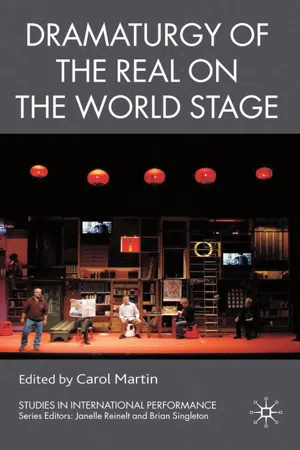Literature
Theatrical Realism
Theatrical realism is a style of theatre that aims to create a lifelike representation of everyday life on stage. It emphasizes naturalistic acting, settings, and dialogue to reflect the real world. This movement, which emerged in the late 19th century, sought to bring a sense of authenticity and truth to theatrical performances.
Written by Perlego with AI-assistance
Related key terms
1 of 5
8 Key excerpts on "Theatrical Realism"
- eBook - PDF
Realisms in Contemporary Culture
Theories, Politics, and Medial Configurations
- Dorothee Birke, Stella Butter, Dorothee Birke, Stella Butter(Authors)
- 2013(Publication Date)
- De Gruyter(Publisher)
Yet, the production’s postdramatic elements create a theatricality whose immediacy and physical-ity at first seem to override the play’s documentary stance. As the analysis will reveal, this theatricality plays a central role in ‘enlisting’ audiences emo-tionally, 6 and thus has a big stake in the production’s realist appeal. My re-marks on these two plays will be prefaced by an overview of the ways in which ‘realism’ is used as a concept in drama theory and theatre studies, in order to then delineate the realist effects each play has on its recipients. I. ‘Realism’ as a Concept in Drama Theory The currency of realism shows not only in contemporary works for the stage, but also in its ongoing employment as a literary term. Analogous to its conceptualisation in theories of the (nineteenth-century) novel, realism as a literary term in the context of drama theory is characterised by a flexible use. First of all, ‘realism’ is defined as a multi-faceted effect of representation re-sulting from the interplay of subject matter, aesthetic convention, and recipi-ents’ horizons of expectation. Secondly, the term ‘realism’ denotes a recur-rent mode which emerged, and was continuously transformed, in the course 5 See Sierz, In-Yer-Face Theatre ; cf. related chapters in Amelia Howe Kritzer, Political Theatre in Post-Thatcher Britain: New Writing 1995–2005 , Basingstoke 2008; Rebecca D’Monté/Graham Saunders (eds.), Cool Britannia? British Political Drama in the 1990s , Basingstoke 2008; Anja Müller-Wood, “ In-Yer-Face Theatre : Sarah Kane”, in: Merle Tönnies (ed.), Das englische Drama der Gegenwart: Kategorien – Entwicklungen – Modellinterpretationen , Trier 2010, pp. 13–30. 6 See Jonathan Bignell et al., “Narrativising the Facts: Acting in Screen and Stage Docudrama”, in: Merle Tönnies/Christina Flotmann (eds.), Narrative in Drama , Trier 2011, pp. 21–52; 34–38. - eBook - PDF
Kitchen Sink Realisms
Domestic Labor, Dining, and Drama in American Theatre
- Dorothy Chansky(Author)
- 2015(Publication Date)
- University Of Iowa Press(Publisher)
Then recall that two of the most often studied iconographic endeavors from the 1950s are the poetry of the Beats and the film Rebel Without a Cause . One did not need to be called to testify before the House Un-American Activities Committee to see cracks in the ideological facade, nor even to have re-sistant opinions on some subjects. Theatre is different from literature in that theatre proceeds on simultaneous, multiple tracks, all of which are available to the audi-ence, and does so in real time. Hence, realism in the theatre is not just the product of the text. In historicizing the late nineteenth-century ad-vent of realism as America’s favorite genre, Brenda Murphy notes that innovations in plays emerged after innovations in stagecraft, mean-ing that the hyperrealistic mise-en-scène (settings, props, costumes, physical arrangements) preceded the earliest recognized realistic play texts by nearly a generation. Murphy uses an inverted and slightly re-labeled version of Aristotle’s criteria for tragedy to name the features that American playwrights worked with to write dramas falling under the rubric realism. The category “stagecraft”—roughly analogous to spectacle—was sixth of six for Aristotle, first for emerging realist play-wrights. American playwrights began to stipulate and comment on 8 I N T R O D U C T I O N detailed settings with the idea that these were not just decoration or backdrop but were important to understanding character and theme. Playwrights also expected actors to bring to life specific, individu-ated characters, and to facilitate this, they provided nuanced, particu-larized ways of talking that (presumably) went beyond stereotypes, with the goal of invoking specific classes, neighborhoods, ethnicities, and personalities. This commitment to verisimilitude as an ordinary way of doing business allowed audiences to trust playwrights’ intro-ducing them to new or strange milieus. - eBook - PDF
The American Play
1787-2000
- Marc Robinson(Author)
- 2009(Publication Date)
- Yale University Press(Publisher)
The painter’s similar affliction may explain why he signed the canvas, as if he had finished it, yet never let it leave his studio, as if he wanted to keep working on it forever. Set against all these self-interrogations, a key principle of Theatrical Realism looks idealistic, if not naive. W. B. Worthen distills (without questioning) the essence of a widely accepted view when he writes that realist practice ‘‘argues that . . . reality can only be shown on the stage by effacing the medium— literary style, acting, mise-en-scène—that discloses it.’’ ∞∏ American theatrical Figure 9: An Actress (Portrait of Suzanne Santje) by Thomas Eakins (1903). The actress’s script lies face down to her right. Philadelphia Museum of Art. Gift of Mrs. Thomas Eakins and Miss Mary Adeline Williams, 1929. Realism against Itself 117 realism doesn’t depreciate when it can’t fulfill this definition. On the contrary, the plays that bear rereading on the far side of modernism are compelling to the degree that they fail at ‘‘effacing the medium,’’ a failure that directs specta-tors to the drama of ‘‘disclosing’’ as much as to anything disclosed. It falls to Theodore Dreiser to school us in the skepticism necessary to appreciate the tension between stage world and real world. Even though ‘‘dramatic art . . . is at once the most natural as well as the most understandable of the graces,’’ he writes in Sister Carrie (1900) as Carrie prepares to make her acting debut in Under the Gaslight, ‘‘it scarcely occurs to the inexperienced onlooker that it must be difficult to be natural.’’ ∞π The earliest examples of American realism are about that difficulty more than anything else—more than the hothouse environments, economic humili-ations, and sexual volatility that typical realists depend on to pull our atten-tion away from the scene of their representation, the stage itself. - D. Tucker(Author)
- 2011(Publication Date)
- Palgrave Macmillan(Publisher)
2 Staging the Contemporary: Politics and Practice in Post-War Social Realist Theatre Stephen Lacey The death of social realism has often been announced in the period since 1940, yet it is still very much alive and has been central to post- war culture in general, and to the theatre in particular. As is evident from this volume, it is a rich and complex term, able to absorb a variety of methods and ideologies. To call a play social realist recognizes that it has political or moral intentions, an engagement with the darker and more controversial aspects of contemporary society and deals with recogniz- able social issues. Social realism refers us to the world in which we live, and access to what a play is about is achieved often by a transparency of form. Social realism sometimes connotes mimesis and verisimilitude, (referred to as ‘naturalism’ and the ‘naturalistic’ in post-war theatrical debate) – an aesthetic that aims to reproduce reality by adhering to its observable, outward forms, and which may be traced across the means of theatrical communication and dramatic writing (colloquial language, for example, a compressed narrative structured into three acts, fully- realized ‘box-sets’, ‘real’ characters, lighting and sound). When social realism is rejected, it is this sense of the term that is often meant. How- ever, the terminology here, as with realism and naturalism generally, is often imprecise, or at least variable and evolving. The aim of this chapter is not to contain this profusion, but rather to trace some of its most persistent features across a seventy-year time span and along different paths. Although a rough chronology will be observed, the approach is thematic, and does not seek to be comprehensive. The focus is primarily on drama that has had prominence in the UK as a whole, and is there- fore, reluctantly, metropolitan in its bias.- eBook - ePub
- Raymond Williams(Author)
- 2014(Publication Date)
- Parthian Books(Publisher)
7 Realism and the Contemporary NovelThe centenary of ‘realism’ as an English critical term occurred but was not celebrated in 1956. Its history, in this hundred years, has been so vast, so complicated and so bitter that any celebration would in fact have turned into a brawl. Yet realism is not an object, to be identified, pinned down and appropriated. It is, rather, a way of describing certain methods and attitudes, and the descriptions, quite naturally, have varied, in the ordinary exchange and development of experience. Recently, I have been reconsidering these descriptions, as a possible way of defining and generalising certain personal observations on the methods and substance of contemporary fiction. I now propose to set down: first, the existing variations in ‘realism’ as a descriptive term; second, my own view of the ways in which the modern novel has developed; third, a possible new meaning of realism.There has, from the beginning, been a simple technical use of ‘realism’, to describe the precision and vividness of a rendering in art of some observed detail. In fact, as we shall see, this apparently simple use involves all the later complexities, but it seemed, initially, sufficiently accurate to distinguish one technique from others: realism as opposed to idealisation or caricature. But, also from the beginning, this technical sense was flanked by a reference to content: certain kinds of subject were seen as realism, again by contrast with different kinds. The most ordinary definition was in terms of an ordinary, contemporary, everyday reality, as opposed to traditionally heroic, romantic or legendary subjects. In the period since the Renaissance, the advocacy and support of this ‘ordinary, everyday, contemporary reality’ have been normally associated with the rising middle class, the bourgeoisie. Such material was called ‘domestic’ and ‘bourgeois’ before it was called ‘realistic’, and the connexions are clear. In literature the domestic drama and, above all, the novel, both developing in early eighteenth-century England with the rise of an independent middle class, have been the main vehicles of this new consciousness. Yet, when the ‘realist’ description arrived, a further development was taking place, both in content and in attitudes to it. A common adjective used with ‘realism’ was ‘startling’, and, within the mainstream of ‘ordinary, contemporary, everyday reality’ a particular current of attention to the unpleasant, the exposed, the sordid could be distinguished. Realism thus appeared as in part a revolt against the ordinary bourgeois view of the world; the realists were making a further selection of ordinary material which the majority of bourgeois artists preferred to ignore. Thus ‘realism’, as a watchword, passed over to the progressive and revolutionary movements. - eBook - PDF
How to Make Believe
The Fictional Truths of the Representational Arts
- J. Alexander Bareis, Lene Nordrum, J. Alexander Bareis, Lene Nordrum(Authors)
- 2015(Publication Date)
- De Gruyter(Publisher)
But the term is useful in distinguishing between those forms which tend to efface their own textu-ality, their existence and discourse, and those which explicitly draw their attention to it. Realism offers itself as transparent. The rejection of the concept of a literary form which reflects the world, however, has led some post-Saussurean critical theorists to use the phrase ‘classic realism’ to designate literature which creates an effect or illusion of reality. This is not just another gratuitous piece of jargon. ‘Classic realism’ makes it possible to unite categories which have been divided by the empiricist assumption that the text re-flects the world. (Belsey [1980, 51]) The Concept of Literary Realism | 21 But if one needs to invent a new term to refer to such works as have been called simply realist, then the question does arise whether the concept of realism itself is not losing its usefulness as a critical instrument. Indeed, this kind of criticism in effect denies the existence of realist literature. If no literary work can be real-ist in the sense that it ‘truthfully/objectively represents reality’, then the con-cept of realism becomes a concept with a null extension and only an ideological function. 3 There are various ways to respond to ‘The rejection of the concept of a literary form which reflects the world’. An immediate and direct response was simply to reject the rejection and insist that literary realism is a form of truth-telling. Real-ist works of literature are interesting and valuable because they do tell the truth about human existence: War and Peace is interesting not only as an account of a particular campaign and of the manners and morals of a certain group of people in a certain place and time. It is great be-cause it has much to say about war and peace at other places and other times. The reality described in a great fiction stands metonymically for a larger reality, or for a whole, infi-nite class of realities. - eBook - PDF
- Matthew Beaumont(Author)
- 2008(Publication Date)
- Wiley-Blackwell(Publisher)
Introduction: Reclaiming Realism Matthew Beaumont Realism is an issue not only for literature: it is a major political, philosophical and practical issue that must be handled and explained as such – as a mat-ter of general human interest. Bertolt Brecht In a useful collection of historical documents about realism in literature that he compiled almost half a century ago, George J. Becker complained that “the subject of realism is not especially congenial to the critics of our day” (Becker 1963: 3). He grumbled that one type of critic in par-ticular – not perhaps ideologically opposed to realism, like those that stra-tegically promoted the modernist movement – had nonetheless “become bored with it and finds that this subject, always rather obvious and simple-minded, need no longer engage the subtle mind of the literary scholar” (Becker 1963: 3). Becker might have been thinking of formal-istic critics like Northrop Frye, for whom realism was in some fundamental sense anti-literary: “One of the most familiar and important features of literature,” Frye had declared in his famous Anatomy of Criticism in 1957, “is the absence of a controlling aim of descriptive accuracy” (Frye 1990: 75). Becker’s complaint also proved to be prophetic, though. In the succeeding decades, philosophers and critics both opposed to real-ism and simply uninterested in it continued to replicate, and indeed to reinforce, the attitude that he had characterized. In an influential essay from 1982, for instance, Jean-François Lyotard collapsed realism into a superficial conception of mimesis, loftily insisting that it “always stands somewhere between academicism and kitsch”; realism’s “only definition,” he concluded, “is that it intends to avoid the question of reality implic-ated in that of art” (Lyotard 1984: 75). - eBook - PDF
- C. Martin(Author)
- 2010(Publication Date)
- Palgrave Macmillan(Publisher)
Can we definitively determine where reality leaves off and representation begins? Or are reality and representation so inextricable that they have become indiscernible? What is the real that needs to be staged? In each geographic location, direc- tors and playwrights as well as theatre audiences have their own answers to this question. Industrial “accidents,” the perpetuation of a culture of death, the failures of social justice, the limitation of truth’s ability to generate heal- ing and change, the rationale of murder, and what it means to be a performer are among the answers offered by the texts in this anthology. The answers are both substantive and technical: about specific subject matter and also about the ways in which theatre and performance artists and their audiences construct their subjects. Beyond subject matter, Reinelt writes that the docu- mentary is “not in the object but in the relationship between the object, its mediators (artists, historians, authors) and its audiences” (7). The relational dynamic Reinelt points out asks us both to know things and to question how we come to know things. Globally, theatre of the real has multiple histories, aesthetic legacies, artis- tic forms, and sociopolitical purposes. This diversity is in keeping with what Marianne DeKoven describes as “not a unified movement or clearly defined Introduction: Dramaturgy of the Real 3 set of aesthetic practices” but a phenomenon that is “diverse, heterogeneous, [and] full of internal contradiction” (2004:16). Part of DeKoven’s discus- sion includes the displacement and suspicion of modernism’s utopian desires by postmodern perspectives. Postmodernism rejected master narratives and universal syntheses “emphasizing the diffuse, antihierarchical, antidualis- tic, local, particular, partial, temporary” (ibid.).
Index pages curate the most relevant extracts from our library of academic textbooks. They’ve been created using an in-house natural language model (NLM), each adding context and meaning to key research topics.
